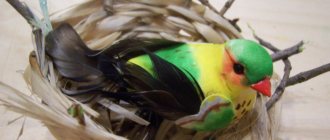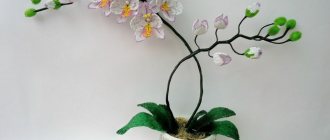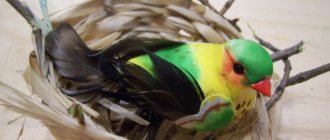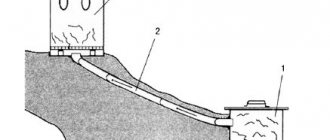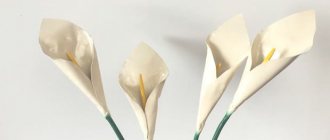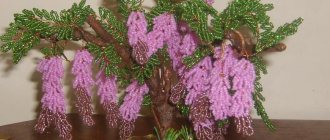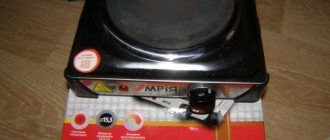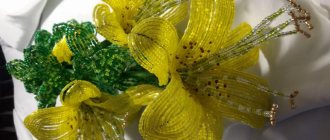Cold porcelain technique
Creating realistic flowers from polymer clay is a popular hobby these days, often called "ceramic floristry", "polymer floristry", "realistic floristry" or "floral sculpture".
This delicate art originated in Japan more than twenty years ago, where the first schools teaching flower sculpting were opened.
To create flowers, two fundamentally different types of clays are used - cellulose-based and starch- and polymer-based. The first type is conventionally called “marshmallow clay”, the second - “cold porcelain”.
Both types of clay harden in air without heat treatment or additional intervention and are therefore also called self-hardening plastics.
The drying speed of such clays depends on the thickness of the rolled layer and the degree of humidity in the room.
The special properties of these materials make it possible to achieve maximum similarity and realism in colors, subtlety and grace in work.
In the process of sculpting flowers from polymer clay and other products, you need to take small pieces of clay from a pack, paint them and wrap them tightly in polyethylene so that the material does not deteriorate.
When sculpting, you need to periodically add a small amount of baby cream (or any fatty cream without fragrance) to the clay - this way you can work with the material longer and not be afraid that it will begin to dry out and crack.
An open pack of cold porcelain must be stored without access to air; it is advisable to wrap it in several layers of polyethylene and place it in an airtight plastic food container.
It is also advisable to wrap marshmallow clays tightly in plastic, then wrap them in a damp cloth and put them in another plastic bag.
This will prevent the clay from hardening and weathering for a long time.
Polymer clay, also called cold porcelain, is denser to the touch than cellulose clay, a little tough to sculpt, and is rolled out into the thinnest layers possible, which allows you to achieve realistic flower details.
As you can see in the photo, flower petals made from cold porcelain after drying become translucent, elastic, flexible, hard and smooth to the touch:
The product hardens completely within several hours, depending on the size and thickness of the parts.
When hardened, the unpainted material gives a yellow or gray tint, slight transparency and takes on the appearance of plastic; to give the petals greater velvety, naturalness and tenderness, a small amount of white oil paint (titanium white) is added to the clay, or cold porcelain is mixed with a piece of white marshmallow clay, which gives it additional softness and whiteness.
Tools
To properly make a flower from polymer clay, you need to have tools in your arsenal, without which working with it will be difficult or completely impossible.
First you need to take care of organizing a flat surface for sculpting. It is best to use a flat plastic board or tile. It is strictly forbidden to use boards for cutting food if it is intended that they will come into contact with food again.
To cut out various elements from polymer clay and divide it into parts, you need to purchase a scalpel or a stationery knife. The ideal choice would be to purchase a special construction knife with interchangeable blades of different sizes and shapes.
Popular articles Cool congratulations on March 8, 2022. How to congratulate women on March 8
To roll polymer clay into thin layers, you must use a rolling pin. A clear acrylic rolling pin works best.
Also take care to buy cling film - when exposed to air, polymer clay loses its plasticity in 10 minutes, after which it becomes unsuitable for work.
Lily
Now you will learn how to properly make a lily flower from polymer clay:
- From polymer, cut out three larger and three smaller petals. To do this, first draw the outline of each petal on the rolled material with a toothpick;
- Squeeze out a textured pattern on the petals using a special form;
- If necessary, paint the petals using a brush and acrylic paint;
- Bend one edge of each petal outward;
- Make white stamens and brown pistils from thin rollers;
- Align the paper clip;
- Attach the stamens to a paper clip, small petals around, large ones in the last tier.
Molds and cutters
When working with cold porcelain, texture molds are used to achieve realism and the correct texture of petals and leaves.
They differ for each specific type of flower, but there are also universal molds that can be used for several different flowers at once.
Molds for flowers made of polymer clay convey in detail the shape of the curves and the pattern of veins of petals and leaves.
Most of the ceramic floristry molds available are made from polyester resin.
They are absolutely hard to the touch, translucent, tough. The assortment is represented by many different plants, but the texture can be a little rough and the clay rolled out too thin can tear on them.
For convenient work, I advise you to coat the polyester resin mold with a small amount of rich cream before use (you can use any baby cream), so the clay will tear less and the petal can be easily removed from the texture.
Also, when mastering the technique of making flowers from polymer clay, it is convenient to use silicone molds for the confectionery industry (for working with mastic).
They are flexible and elastic to the touch, their designs are thinner and more realistic, the print is delicate and neat, and at the same time the clay does not stick to them or tear.
You can make a silicone mold yourself from two-component silicone sealant, and you are guaranteed to get a realistic imprint from any interesting plant that will last a long time.
To make beautiful flowers from polymer clay, cutters—metal or plastic cutting molds—are used to create petals and leaves of the most correct and realistic shape.
They make the work much easier and faster; all elements turn out smooth and identical.
It is most convenient to use cutters in combination with a pasta machine - initially roll out a thin layer of cold porcelain in it, placing it in a special film, and then cut out the required number of elements with a cutter.
Roses
Probably the most beautiful flower ideas made from polymer clay are artificial roses. Their production is described below:
- Roll a rope out of polymer clay and divide it into 9 balls;
- Each ball should be placed on the palm of your hand and a circle should be molded out of it. One end of the circle should be thicker, the opposite end should be very thin;
- The petal needs to be pressed with a ball on the stack so that it turns out curved;
- One of the petals needs to be rolled up and attached to a wire;
- Wrap the remaining petals around the base, each of them should cover half the previous tier;
- Bend the ends of the petals slightly outward;
- Let the rose dry.
Note!
- Macrame: diagrams, interesting projects and detailed descriptions of making crafts
- Crochet amigurumi - examples of how to make a beautiful toy with your own hands (75 photos)
- Coffee topiary: step-by-step master class on how to make a small decorative tree from coffee beans
With each new flower, your products will turn out more and more accurate and realistic. Ready-made flowers made from polymer clay can decorate your interior, become an excellent gift for family and friends, and can also bring additional income. Flowers made from polymer clay are popular, especially when decorating weddings.
Safety precautions
Each master class on flowers made of polymer clay should begin with studying the safety rules when working with this material.
Despite manufacturers' statements about the safety of polymer clay, it contains phtholates, which can negatively affect human health if the material is handled carelessly and carelessly. It is best to work with polymer clay while wearing thin latex gloves. When working with plastic, it is not advisable to eat or smoke.
If you bake polymer clay in a home oven, then after polymerization of the products you need to clean it well. It is best to place a deep dish filled with water and set the oven temperature to maximum for 10-15 minutes, then turn off the gas and leave the door open for 20-30 minutes.
Tools for working with polymer clay
Before you start work, you need to prepare everything you need:
- Polymer clay.
- Working surface. It should be a flat, smooth surface. You can use glass, plastic, ceramics.
- Small knife. A construction or stationery knife with spare blades will do.
- Rolling pin for working with acrylic. You need to choose one that makes it convenient to roll out the clay.
- A syringe with special attachments for making curly stripes and floral elements.
- Cutters. Molds designed for cutting out shapes.
- Stacks. Tools for working with plastic materials (clay, plasticine).
- Varnish for coating polymers.
- Brushes of different sizes.
- Wooden toothpicks.
- Napkins.
- Accessories.
Materials and accessories for work
During the work you will need:
- Polymer clay.
- A smooth work surface, in particular a board made of glass, ceramics or plastic.
- Knife.
- Acrylic rolling pin.
- A syringe with a variety of attachments for making fine plant parts.
- Cutters, that is, forms for cutting out patterns and details of crafts from paper.
- Brushes, toothpicks, decorative elements.
- Napkins.
- Varnish.
Master class for beginners
Homemade polymer clay flowers are usually more realistic than those made from any cellulose clay, because cellulose clays are completely matte and do not provide the same fineness and transparency as cold porcelain.
The process of working with cold porcelain is longer and more labor-intensive, but it opens up great scope for the implementation of ideas.
Cellulose clays are very soft, delicate and velvety to the touch, light and pleasant to sculpt.
For beginners making flowers from cold porcelain, it is much easier and faster to work with such materials, you can get by with fewer tools and devices, often no molds, no glue, no cutters, no additional dyes are required - any shade can be achieved by mixing different clays colors in any proportions.
Ready-made flowers are lighter in weight and more decorative than those made from cold porcelain. When frozen, the petals are completely opaque and matte.
Hand-made flowers from cold porcelain require careful handling, but are not fragile and do not break when dropped.
When in contact with water, flowers from both types of clays may lose shape and/or color, so dry cleaning of the products is preferable, for example, using a large brush.
Once made, polymer clay flowers can be further protected by covering them with a layer of matte or shiny acrylic varnish for ceramic floristry.
The video “Flowers from cold porcelain” shows how products are varnished:
White orchid lip tinting
Using an applicator and dry crayons, apply bright yellow or purple pigment to the lip (pattern part No. 1). Tint the workpiece on the reverse side with less bright colors, which will give the element a translucent effect.
Tint the “chair” blank (pattern part No. 5) purple on both sides in the same way and place it in the middle of the lip.
Apply specks of acrylic or oil paint to the lip using a thin brush. Receive: the back side is tinted, the front side is stained.
Note!
- DIY feeder - step-by-step instructions for creating a feeder + detailed diagrams with photo reviews
Do-it-yourself rugs - TOP 120 simple patterns with master classes on how to make them yourself + photo reviews of finished rugs
- Do-it-yourself dolls: a master class on making a beautiful doll. Simple instructions with photo examples of ready-made options
Recipe for making polymer clay at home
If you don’t have ready-made clay, you can make it at home. But do not forget that homemade clay cannot be called a full-fledged analogue of purchased material, since it will only vaguely resemble it, mainly due to its softness and ability to harden. The composition will be completely different.
To create a mass for modeling at home you will need:
- corn or potato starch (with corn starch the mixture will be lighter) – 100 g.
- glue – 100 g.
- lemon juice – 2 tbsp.
- hand cream or Vaseline – 1 tsp.
- mineral oil (for example, baby oil) – 2 tsp.
- heat-resistant container and mixing spatula.
Method of preparation: combine starch, glue and Vaseline, mix everything well until smooth. Add lemon juice and oil. Place a heat-resistant container in a water bath at moderate heat and, stirring constantly, bring to a mushy consistency. Remove from heat and mix the resulting mass thoroughly. Let cool completely. To avoid drying out, store in a cool place, tightly wrapped in film.
If you need to make the material colored, then add pigment during the kneading process. You can also paint finished work. It is advisable to use acrylic paints and fix the result with polymer varnish.
How to make a keychain with your own hands - many master classes and creative photo ideas
Do-it-yourself foam crafts - features of work, master classes, photo examples
Chandani and her brand ChaNoJa
She lives in Switzerland, works for a transport company, and makes jewelry in her free time. Chandani also loves to travel.
She has traveled to Southeast Asia, the Middle East, the United States, Canada, Ghana and Costa Rica, exploring different cultures and customs that have broadened her worldview.
The brand “ChaNoJa” is named after three masters - Chandani - Norbert - Yael. Chandani's enthusiasm was so infectious that her friends joined her.
❝My life was exciting and adventurous in many ways, but something was missing: creative expression! In 2013, I learned about polymer clay, was inspired by the works of artists and decided to try it myself. I realized that creating clay jewelry is my calling... My art is created from my soul and my heart, not from my head. Beauty lies in “imperfections that are perfect,” as in nature. I feel like my talent is a gift from the Universe!❞
Making flowers
To quickly learn how to sculpt flowers yourself, you need to start with simple work in order to understand the basics of working with such a capricious material.
For beginners, it is best to start learning how to make simple flowers such as callas. To make this flower, you need to take clay of two matching colors, latex gloves, a stationery knife and stacks. Instead of stacks, you can use simple toothpicks.
Roll both pieces of plastic into long sausages and wrap one of them around the other. After this, roll the clay and one ball. Divide it again into 2 balls, and then into 2 sausages. Tear them into 3-5 pieces and roll into 1 ball. This will help you achieve a marbling effect.
Next, carefully cut the ball into 2 equal parts. Form them into 2 pancakes with a slightly elongated edge. Lightly pinch it with your fingers. Fold the bottom edge into a funnel shape and slightly open the flower.
For more complex flowers, the petals must be cut individually with a knife. To give flowers a more natural look, you can give them structure using molds or stacks.
You can also use acrylic paints to tint plastic. Beautiful ideas for flowers and their manufacture can be gleaned from sites dedicated to the manufacture of such products.
Preparing patterns for work
You should start working by preparing templates from cardboard, according to which you will cut out parts from foamiran. Our patterns are an exact copy of the elements of a real Phalaenopsis orchid.
When you carefully examine the flower, you probably noticed that the lower inflorescences are much larger than the upper ones. The patterns also come in different sizes: large (M) and small (S). On one branch, as a rule, there are 2-3 small flowers (S), 3-4 large ones (M) and 2-3 buds. The pattern for the buds is designated No. 4, it also has sizes M and S. Pattern No. 5 is cut out in size 6x6 mm with teeth on opposite sides. For convenience, copy our patterns and proceed to the main work.
How to work with polymer clay?
First, learn some rules:
Wash your hands thoroughly, as clay absorbs dirt
The work surface should be perfectly clean, and it is better to wear a scarf on your head. Apply talc to the clay so that it does not stick to your hands. It is better to accurately calculate the required amount of material; painted clay does not last long. If the clay is dry, you should add a little hand cream. The work requires caution and accuracy; clay crafts are fragile. The materials are sold in packaging, do not open them in advance. To preserve the clay for a long time, it is better to put a damp cloth in the package.
Making flowers from clay
When the clay is ready to work and all the necessary tools are at hand, we begin to create.
Rose
These beautiful flowers occupy a leading position in popularity, both in live form and as a model for creativity.
The process of preparing a rose from polymer clay: take part of the material, make an oblong sausage out of it, cut into 7-9 pieces. Roll them into balls about a centimeter in diameter. To create the center of the flower, take the first ball, roll it out and twist it into a spiral. From the remaining parts you need to make petals. Place the ball on your palm and spread it with the thumb of your other hand, forming a petal. In this case, the upper edge of the petal should be thinner and the lower edge thicker.
After processing all the balls in this way, we begin to collect the flower. Take the center of the future rose and carefully attach the petals to it. Place each next petal overlapping the edge of the previous one.
A clay rose is well suited for decorating jewelry or assembling a bouquet.
How to make a dress out of paper with your own hands - working with the material, types, tips, photos
How to make a cat craft with your own hands - review of materials, step-by-step instructions for beginners, photo examples
Orchid
Now let's start creating an exquisite orchid. In addition to the basic tools for work, you will need: wire, a stack with rounded ends, a mold to imitate the surface of a sheet, paints of the desired shades.
In order to make an orchid you will need three elongated oval petals, two large round petals and the middle of the flower.
We form a sausage from a piece of polymer clay of the desired color, roll it out to 2-3 cm. We pinch one edge and separate it into petals with a knife. Each of the resulting sections must be given the desired size, shape and texture. To obtain characteristic irregularities and veins, a special mold is used.
Lay the bottom row of elongated oval petals with the Mercedes badge and make a depression at the point of their contact. Give a slightly wavy shape to the edges of the petals. Next, place round petals in the center, smooth them out in the same way, and model the edges. Roll out some of the light clay to about 3mm. For the core of the orchid, cut out a small figurine in the shape of a nesting doll.
Popular articles Decorative pillow
Place it on your palm and stretch out the edges using a stack. If desired, you can tint it with pink pastels. Place the resulting blank in the middle of the flower and lightly press with a round stack. Roll a small ball, making a transverse stripe on its surface, and place it in the central recess.
The orchid is ready, all you have to do is bake it!
Calla lilies
These easy-to-make flowers are ideal for beginners.
You will need two shades of clay, a knife, a toothpick and decorative beads.
Roll out the clay mass into separate sausages of different colors. Tuck them under each other, resulting in a ball. Repeat the steps several times until you get a marble effect. Then cut the ball in half.
Spread one portion over your palm. Pull the bottom edge out and pinch it with your fingers. Carefully fold the top edge, like a paper bag.
You can put decorative beads in the middle. You have made a calla bud!
Lily
Thinly roll out some of the clay of the desired color, mark the boundaries of future petals with an awl or needle. In total you will need three large and three small petals
Carefully cut out the pieces with a sharp knife. To enhance the effect, you can draw lines that imitate the veins of a petal
Leave the resulting fragments to dry. At this time, prepare the center of the flower, consisting of the pistil and stamens. Roll out a piece of clay and cut into narrow strips. Make one of them wider than the others, and make a pestle out of it.
To assemble the lily, take a wire or a straightened paperclip and secure the pistil and stamens to it. Then attach the petals symmetrically, starting with the small ones. The lily flower is ready!
Modeling a cymbidium orchid from polymer clay
Today I sat down to work early in the morning and just finished. I tried to show you everything in as much detail as possible, but I will be happy to answer any questions. Friends, I will repeat that I did a master class on exactly how I sculpt an orchid. Perhaps I’m doing something not quite right and I’ll be glad if experienced professionals give advice! I also want to express my deep gratitude to my husband for helping me film everything. I will be glad if you later show me what flowers you managed to make with my help! And later I’ll conduct a survey on how useful my photos were. When copying materials, a link to the original source is required.
To begin with, a photo of a living flower, which I dissected a long time ago to make my very first cymbidium.
This was the result!
Now I propose to make an orchid like this!
This is a photo of a living flower
Basic materials needed for sculpting.
Mix the color of the clay. Add a little yellow and even less ocher.
Roll out the clay using a pasta machine to thickness No. 6.
The rolling thickness may vary on different machines. We need the petals to be dense after drying, like those of a living flower.
Be sure to thin the edges along the entire perimeter of the petals (visible in the light).
After we take the petals out of the film, we need to let them dry a little, literally less than a minute, then carefully place them on the mold. (The mold can be pre-lubricated with baby oil to prevent the flower part from sticking).
Then we roll out the edges a little, making them thinner and more wavy.
The tip of the petal can be made sharper by pinching it and using your fingers to shape it into the desired shape.
Now let's start forming the orchid's lip. The edges of the part also need to be rolled out and thinned.
In the places indicated by the stack, I roll out the clay a little, moving the stack left and right to form a fold on the front side of the lip. Afterwards we leave the part to dry a little.
Then, carefully, so as not to tear the clay, we twist it onto a stack, as shown in the photo below.
Forming the orchid's lip. Round the edges with a stack of balls from the edges to the center. We do this with light pressure on the dried part. Using a stack with a small ball, we make a small bend on the back side of the part. This way the lip will take the correct shape.
Using a stack with a large ball, we shape the petals so that they are not flat. Roll the stack along the edges with slight pressure. The petal should not be sticky at this moment; it must first be dried. But, most importantly, do not overdo it, otherwise the clay will crack, turn white and break.
To ensure that the lip holds its shape better and does not break, we glue the wire on the back side with super glue, having first bent it to the desired shape. In this case, wire No. 22. But I think it could be thinner. After tinting, the wire on the front side will not be visible at all.
The desired shape has been achieved. Let the part dry.
Next, we begin to sculpt the orchid column. I use a special form. It is important that before starting work the mold is clean, without any remnants of old clay. Before placing the clay in it, grease the mold with baby oil. This will prevent the clay from sticking and will make it easier for you to remove the part from it.
We roll the sausage a little longer than the mold and carefully place it inside, carefully distributing the clay so that there are no voids and the texture is imprinted well.
Using a stack with a ball (I don’t have the right size, so I use the opposite end of a cat’s paw stack), we make a depression in the column. Don't keep the part in the mold for too long, otherwise you will have a hard time shaping it later. It is better to grease the mold more thoroughly with oil.
We finalize the column and give it the desired shape. After we take the part out of the mold, we must make sure to correct it. First you need to make “sides”, like a living flower. We give the desired shape with our fingers, very carefully so as not to tear the clay.
Use a stack to adjust the shape of the spout on the column. Look at as many pictures as possible on the Internet, or better yet, study a living flower to understand what this element looks like.
I sculpt the inner element of the orchid's lip by hand, without using special tools. We make a small sausage. Then use a stack knife to make a depression, after which we roll out the stack and thin the edges, as shown in the photo. The part should resemble the shape of a checkmark.
After drying, glue the inner part with super glue. We reinforce the orchid column with wire No. 22. This way we can give the part the desired bend, and we will also need this wire when assembling the flower.
Lubricate the wire with latex glue. (I do not recommend using super glue in this case, because if you do not have time to move the wire to the required depth, it will instantly harden at the very base).
The wire must first be slightly bent. It can be inserted into the column only after the part has dried sufficiently from the outside, so as not to wrinkle it.
To ensure that the orchid's lip retains the desired shape when it dries, I use this trick (see top photo on the right).
Now let's hide the wire. To do this, roll a thin sausage of the required length. We distribute the clay in the film for the pasta machine and make it thinner at the edges. We glue the resulting clay with latex glue to the orchid's lip on the back side. We distribute the clay so that there are no seams and the wire is securely hidden. Let's do this using water and a silicone brush (or a simple brush with synthetic bristles).
Let's start tinting.
Apply light green paint to the petal, and then blend it with a semi-dry brush. On the palette, the paint can be diluted with a small amount of art thinner. This way the paint will dry faster, but will not apply as intensely.
Apply grass green oil paint closer to the base of the petal. Let's blend it out.
We tone the edges of the petals with ocher paint and also shade them. We tint the petals at the base with cherry color, and lightly tint the corners with pre-rubbed pastel chalk of a reddish-brick color.
Apply and blend light green paint at the base of the orchid’s lip, as well as at the base of the column.
Let's tone the orchid's lip from the reverse side.
Using chaotic movements and using enough paint so that it falls in droplets, we apply a pattern to the orchid’s lip. To paint the lips I use acrylic glass paint. It looks the brightest and most advantageous. However, you can also use simple acrylic paints. They are bright and dry quickly.
Glue the orchid's lip to the column at the very base using super glue. First, attach the parts to each other, since super glue does not allow you to adjust the position of the parts after just a few seconds. Then your movements should be clear and precise.
We will also coat the wires with glue and press them tightly together, so the structure will be much stronger. After the glue has dried, wrap the wire with tape.
Let's glue the petals. Apply a small drop of glue to the very base (first, attach a petal to see if it lies evenly). Firmly but gently press the petal so as not to deform the orchid column.
First we glue the side petals, then the lower and upper ones.
Our flower is almost ready. All that remains is to mold and protonate the stem.
For the stem, roll a sausage and make a hole in it with a stack. The stem wire must be very well lubricated with latex glue. Then we put the clay on the stem to the very base of the flower and press it well.
We put the clay on the stem and carefully pull it down, gradually pressing and leveling it.
Quickly move your fingers up and down to smooth out the stem. We do this with virtually no pressure on the stem, so as not to deform it, but on the contrary, we only lightly touch it.
Using a silicone brush, carefully apply the flower stem to the petals. Wet the brush with water. The clay on the stem should be quite damp, then it will be smoothly leveled.
We smeared the stem with a silicone brush and carefully smoothed the joint with a wet finger. We cut off the excess. Leave the stem approximately 4.5 - 5 cm long.
Let's protonate the stem to make it look more alive and be sure to give it a bend.
The wire should not be cut if you plan to make a branch of cymbidium orchids. You will need it to attach the flower to the stem.
Congratulations! Your orchid is ready.
Thanks to everyone who read and watched to the end! Good luck to you creatively!
How to make polymer clay with your own hands
If you can’t buy ready-made polymer clay in a store, you can make it yourself at home by following a simple recipe.
Required ingredients:
- Flour – 1 tsp.
- Children's cosmetic oil.
- PVA glue – 1 tsp.
- Corn starch – 1 tsp.
To prepare a plastic material, flour must be combined with starch and glue added. Stir the resulting mass until it becomes clay-like. After this, add five drops of oil so that the mixture does not stick to your hands.
Paint the clay with acrylic paint. Dropping a few drops onto a piece of clay, knead it in your hands until a uniform color is obtained.
Preparing for the creative process
To create a white orchid with your own hands, you will need the following materials: white foamiran, wire No. 24 or No. 26, light or dark green tape, several cotton swabs, a piece of cotton wool, glue (PVA, second glue-gel, “moment crystal”) , acrylic paints, crayons or dry pastels, orchid texture, thin brush, tweezers, scissors and iron.
Sequence of work
Paint the clay with a brush, and form a small protrusion in the center of the piece. To make the center of the flower, cut a cross from a piece of clay using a cutter. If there is no form for cutting, you must do it yourself with a knife. The ends of the cross-shaped workpiece are consistently bent inward.
Then bend the wire at an angle of 90 degrees. Place the center of a flower coated with glue onto the end of the wire.
Make the middle of the flower in the form of a small grain, on which an incision should be made, and place it in the center of the orchid. The flower is decorated in all available ways.
A painted piece of clay with a projection is rolled out and placed in a mold. The required number of petals is made in the same way.
In case of difficulties encountered during the work, it is recommended to familiarize yourself with photos and video master classes on making flowers from polymer clay published on the world wide web.
Stages of work on making a rose
Roll a cylinder out of clay, cut it into unequal sections, from which roll into balls. The resulting balls should be of different sizes.
Make petals out of them in the shape of an ellipse. To do this, press the workpiece with your thumb to make it flat, and then a petal is formed from each ball.
One edge of the petal should be thicker than the opposite. The center of the flower is made from a petal rolled into a roll.
We recommend reading:
- Weaving from newspaper tubes for beginners: the best free master class, with step-by-step instructions. Photos, diagrams, unusual ideas, videos
- Paper rose - how to make it yourself? Step-by-step instructions, original ideas, photos, videos, master class
DIY clock decor - a review of the best ideas for decorating at home. TOP 100 photo ideas + video
Then a bud is assembled from the resulting petals, successively increasing the size of the petals towards the periphery. When assembling, you should assemble the bud so that the next petal covers at least the middle of the previous one. This rose will look good as a magnet on the refrigerator.
Instructions for working with clay
To make the creative process as enjoyable as possible, and to make your products beautiful and neat, when working with polymer clay, follow the following rules.
Safety precautions
- work only with protective gloves;
- do not bake objects made of polymer clay at the same time as cooking;
- do not exceed the temperature range, as when overheated, the material releases toxic substances that can cause poisoning;
- After baking, ventilate the oven and kitchen.
Adviсe
before you start creating clay products, you need to knead the material well with your hands, so it will become warm and pliable, which will simplify working with it; do not allow air bubbles to enter, this may deform the finished product; To avoid drying out, store the bag with polymer clay tightly closed; the sticking of specks to the clay will help prevent talc; do not remove crafts from the oven immediately after baking, as cracks will form with a sharp temperature change; finished polymer clay crafts are fragile and therefore require careful handling.
Today, polymer clay modeling is a popular form of creativity among adults and children. This process is very exciting and once you create your first clay accessory or decorative item yourself, you won’t be able to stop!
From this article you learned what polymer clay is, what tools are needed to work with it, how to prepare clay yourself, how to make flowers, and also received tips on how to properly work with this material.
Come up with and implement your ideas in clay products to decorate your home, as a gift to friends, or for sale.
Success in creative work!
Stages of creating a peony
- Add a little red clay to the white clay and mix together using stretching movements.
- Divide the resulting mass into 12 pieces of 1.5 cm and 20 pieces of approximately 1 cm.
- Form teardrop-shaped elements from the resulting pieces. Pinch the thickened tip and smear it over your palm, and then, using a stroking motion, make a concave petal with a small stem.
- Glue the petals in pairs - large with large, small with small, moving one of the two to the side.
- Fan together the smaller pieces so that the concave side is on the inside.
- Form the center of the peony by twisting the resulting fan in a spiral.
- Glue the remaining large petals around the central part with the convex side inward.
Creating leaves
- Mix green and white clay. Once you have a light green color, add a little more green, but do not mix them together completely. This will give you a veined texture.
- Make a drop, press it to the surface of a special acrylic mold to obtain a sheet.
Making buds
- The pink clay remaining when creating the flowers is mixed with red, but not mixed completely. Roll the resulting plastic into a ball with a diameter of approximately 2 cm.
- Three or four small cakes are made from green plastic that was not used for leaves, and then they are glued over the bud so that they look like sepals.
Each piece is glued to floral wire and left to dry completely for 24 hours.
Assembling the boutonniere
- Wrap the wire elements with tape. To make it fit better, stretch it before use. Using regular tape, connect the pieces together. There is no need to make the stem too long. Leave no more than eight centimeters, cut off the excess with pliers.
- Tape is also used for wrapping the base under the boutonniere. Wrap the ribbon around the stems and secure the end with a pin. The final touch will be a bow made from ribbon.
Forming a bouquet
If you are creating a full-fledged flower arrangement, there is no need to use tape. The wire in the bouquet will be almost invisible.
- To get a beautiful bouquet, connect several flowers using tape. Once it is formed, add leaves to the composition.
- Mark how tall the bouquet should be, cut off the excess stem into pieces. Reliability of fixation can be achieved with pins, which are used to pin each turn made.
- The resulting luxurious bouquet of peonies is decorated with a bow.
Assembling orchid buds
To form buds, take a wire with a loop on the edge, wrap cotton wool around it in the form of a bud. Wrap the wire under the bud with tape in the form of a stem. Wrap the cotton wool bud in the blank according to pattern No. 4, gluing all the petals together.
Note!
- Corrugated paper flowers: TOP 100 photos of ready-made options + instructions on how to make them yourself
- DIY family tree: instructions for creating a family tree + DIY design ideas
- Do-it-yourself sun lounger: photos with instructions for creating sun loungers + detailed diagrams of the stages of work
The resulting buds need to be slightly tinted with yellow pastel with dark green shadows and red pigment. To set the tint, take hairspray and spray the buds with it.


